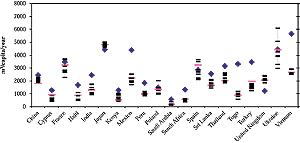|
4.5.2. Impacts of Climate Change on Water Resources: A Global
Perspective
There are several indicators of water resource stress, including the amount
of water available per person and the ratio of volume of water withdrawn to
volume of water potentially available. When withdrawals are greater than 20%
of total renewable resources, water stress often is a limiting factor on development
(Falkenmark and Lindh, 1976); withdrawals of 40% or more represents high stress.
Similarly, water stress may be a problem if a country or region has less than
1,700 m3 yr-1 of water per capita (Falkenmark and Lindh,
1976). Simple numerical indices, however, give only partial indications of water
resources pressures in a country or region because the consequences of “water
stress” depend on how the water is managed.
At the global scale, assessments of water stress usually are made by country
because that is the unit at which water-use data generally are available. In
1990, approximately one-third of the world’s population lived in countries
using more than 20% of their water resources, and by 2025 about 60% of a larger
total would be living in such stressed countries, in the absence of climate
change (WMO, 1997), largely because population growth. Arnell (1999b, 2000)
estimates the effect of a number of climate change scenarios on national water
resource availability and compares this with estimated future demands for water
(increasing following the CDS outlined in Section 4.4).
Table 4-6 shows the numbers of people living in
countries using more than 20% of their water resources in 2025 and 2050 and
in which the amount of resources decreases by more than 10% as a result of climate
change. There is considerable variability between scenarios, essentially reflecting
how resources change in populous countries, but by the 2020s the table indicates
that about 0.5 billion people could see increased water resources stress as
a result of climate change. Significant geographic variations are hidden in
Table 4-6. Under most of the scenarios considered,
climate change increases stresses in many countries in southern and western
Africa and the Middle East, whereas it ameliorates stresses in parts of Asia.
Alcamo et al. (1997) found broadly similar results.
|

Figure 4-4: National water resources per capita (m3
yr-1), in 1990 and 2050 under several climate change scenarios,
for some countries (Arnell, 2000). Blue diamonds represent 1990; long
pink bars 2050 with no climate change; and short black bars 2050 under
different climate change scenarios.
|
Figure 4-4 shows water resources per capita in 1990 and
2050 for a set of countries,as listed in Table 14-3
of the WGII contribution to the SAR, showing resources per capita in 2050 without
climate change (long line) and under eight climate change scenarios (short lines)
(Arnell, 2000). There are some differences with the earlier table because of
the use of updated data sets, but similar conclusions can be drawn. Climate
change tends to have a small effect relative to population growth, and the range
of magnitudes of effect between scenarios also is little changed; the effects
are still uncertain. For most of the example countries, climate change may result
in either an increase or a decrease, although for some the climate change signal
is more consistent (reductions in South Africa, Cyprus, and Turkey, for example,
and increases in China). Note that these figures represent national averages,
and different parts of each country may be differently affected.
| Table 4-7: Effect of stabilization of CO2
concentrations on numbers of people living in water-stressed countries adversely
affected by climate change (Arnell et al., 2001). Climate change under each
emissions scenario is simulated with HadCM2 general circulation model; other
climate models could give different indications of the effect of stabilization. |
 |
|
|
Total
Population
|
Population in
Water Stressed Countries
|
Number of People (millions) in
Water-Stressed Countries with
Increase in Water Scarcity
|
|
|
(millions)
|
(millions)
|
IS92a
|
S750
|
S550
|
 |
|
2025
|
8055
|
5022
|
338–623
|
242
|
175
|
|
2050
|
9505
|
5915
|
2209–3195
|
2108
|
1705
|

|
Table 4-7 gives an indication of the potential effect
of stabilizing GHG concentrations on the total number of people living in water-stressed
countries adversely affected by climate change (Arnell et al., 2001). The results
are conditional on the climate model used and the stabilization scenario, but
this study—using just the HadCM2 climate model—suggests that by the
2050s the “weaker” stabilization target has little effect on the total
number of impacted people, and although the “stronger” target reduces
the impact of climate change, it does not eliminate it. The changes by the 2020s
are very much affected by climatic variability between the various GCM runs.
|